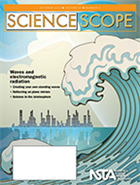Waves and electromagnetic radiation
By Mary Bigelow
Posted on 2013-10-13

As the Science Scope editor notes, “Most of our students—and many adults—take modern technology for granted, never wondering how these machines work or what science makes them possible.” Much of this science relates to waves and electronic radiation, and the featured articles in this issue have many ideas for student investigations in these topics, and the articles note how the content and activities relate to the NGSS.
Reflecting Understanding describes some misconceptions students may have about light and plane mirrors. The article describes four learning stations using a “reflect-view” mirror (described in the article). The authors include photos of the stations and discuss how each addressed a misconception. [SciLinks: Reflection, Mirrors]
As the author of Color: The Eyes Have It notes, middle schoolers enjoy learning about themselves. This activity here goes beyond a traditional lesson in the genetics of eye color to have students take a closer look at their own eye colors through digital photography. [SciLinks: Eyes]
Balloon’s Up! illustrates a project in which students partnered with a university for an authentic exploration how ultraviolet radiation, visible light, and sound waves are affected by altitude. Students with their partners designed research projects that could be studied with data collections from the high-altitude balloons they launched.
The authors of Wave Warnings provide suggestions for helping students investigate wave characteristics in water. Making wave “prints” (directions provided) give students a picture of their generated waves and provides an opportunity to study the characteristics of real waves in addition to pictures in a textbook or website. The article has photographs of the prints and student handouts. [SciLinks: Waves]
Two of the monthly columns also focus on waves. Are there sounds in space? The Scope on the Skies article The Sound of Sound has a review of wave characteristics and discusses acoustical sounds vs. the conversion of forms of electromagnetic radiation of celestial objects into acoustical sounds we can hear. [SciLinks: Electromagnetic Waves] When studying waves, students often use thing such as Slinkys, mirrors, lenses, and tuning forks. The Scope on Safety article Wave Warnings has some suggestions for studying waves safely in the classroom.
Students may bring a variety of backgrounds and interest in these topics. Differentiating Inquiry (in this month’s Teacher’s Toolkit) has suggestions for varying the level of inquiry in a topic. Using density as the topic, the authors provide examples and materials for meeting the need of students. The ideas can be generalized to any topic. [SciLinks: Density]
Disclaimer: The views expressed in this blog post are those of the author(s) and do not necessarily reflect the official position of the National Science Teaching Association (NSTA).


